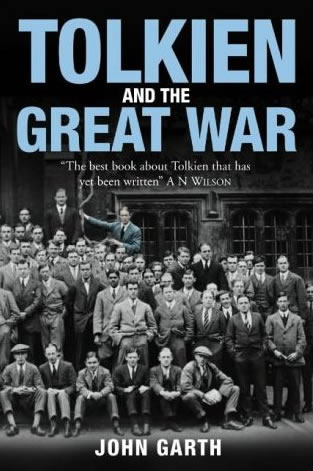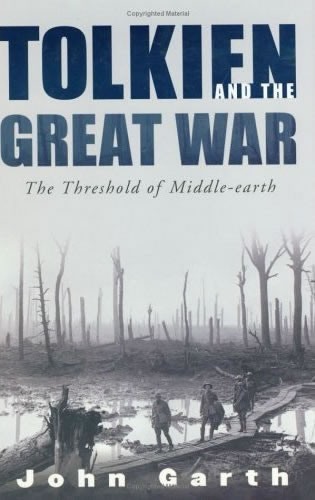Books about J.R.R.Tolkien - Tolkien and the Great War: The Threshold of Middle-earth
This dense but informative study addresses the long-standing controversy over how J.R.R. tolkien's WWI experience influenced his literary creations. A London journalist, Garth is a student of both Tolkien and the Great War. He writes that when war broke out, Tolkien was active in an Oxford literary society known as the Tea Club and Barrovian Society (TCBS), along with three of his closest friends. Finishing his degree before joining up, Tolkien served as a signal officer in the nightmarish Battle of the Somme in 1916, where two of those friends were killed. The ordeal on the Somme led to trench fever, which sent him home for the rest of the war and probably saved his life. It also influenced a body of Northern European-flavored mythology he had been inventing and exploring in both prose and verse before the war, toward its evolution into The Book of Lost Tales and in due course Lord of the Rings and The Silmarillion. This book could not pretend to be aimed at other than the serious student of Tolkien, and readers will benefit from a broad knowledge of his work (as well as a more than casual knowledge of WWI). But it also argues persuasively that Tolkien did not create his mythos to escape from or romanticize the war. Rather, the war gave dimensions to a mythos he was already industriously exploring. Garth's fine study should have a major audience among serious students of Tolkien, modern fantasy and the influence of war on literary creation.
Review:
From the title, I assumed that John Garth's Tolkien and the Great War would be a very short book. After all, a great deal of tolkien's Great War experience consisted of lying flat on his back in a fever ward recovering from a near-fatal case of trench fever. tolkien's WWI combat service was very brief. He went to France in early June of 1915, first saw combat in mid-July, developed trench fever in late October and was shipped back to England in early November of the same year. Though WWI had a powerful impact on Tolkien, he nowhere gave explicit details on how the war influenced his storytelling, nor did he make any point-to-point correlations between the battlefields of World War I and the landscape of Middle-earth.
Instead of being just an account of tolkien's abbreviated combat service, John Garth’s Tolkien and the Great War fleshes out Thomas Shippey's claim that Tolkien was part of a generation of "traumatized authors" who attempted to express the horrors of World War I through the writing of fantasy. Garth believes that Tolkien’s experience in the Great War, and in particular the loss of two of his closest friends at the Battle of Somme, had a profound effect on the mythology he invented. He argues that without the catalyst of World War I, Tolkien might have not written at all, or might have developed into nothing more than a pale imitation of William Morris. Tolkien’s mythology, he writes, was born on the battlefields of World War I, and that is why Middle-earth "looks so engagingly familiar to us and speaks to us so eloquently, because it was born with the modern world and marked by the same terrible birth pangs."
The story begins with the TCBS, the Tea Club and Barrovian Society, a fellowship of unusually talented, well-educated and idealistic schoolboys who met to trade ideas and indulge in clandestine tea breaks, and who ultimately shared the conviction that they would somehow change the world. The core members of the group were Tolkien’s closest friends, Christopher Wiseman, a fledgling composer, Rob Gilson, a would-be artist and architect, and Geoffrey Bache Smith, an aspiring poet.
The four friends all went to serve in the war, and Gilson and Bache Smith suffered deaths that were both tragic and ironic. Gilson, "a gentle aesthete" who abhorred war, died heroically, leading a hopeless charge across No Man’s Land. His legacy as an architect consisted of a "widely circulated platoon drill for coordinated trench digging." Poet Geoffrey Bache Smith spent most of his military career writing the "anti-poetry" of military dispatches. He died of gangrene poisoning from a very minor wound. Although Garth doesn’t make this claim, I don’t think it’s too farfetched to suppose that in The Lord of the Rings, the four members of the TCBS were transmuted into four remarkable hobbits.
In a letter he wrote to Tolkien from the trenches, Geoffrey Bache Smith wrote: "My chief consolation is, that if I am scuppered to-night... there will still be left a member of the great TCBS to voice what I dreamed... may you say the things that I have tried to say long after I am not there to say them, if such be my lot." He continued that the TCBS "had been granted some spark of fire that was destined to kindle a new light in the world... The death of one of its members cannot... dissolve [it]."
Garth maintains that survivor guilt, combined with a sense of being chosen for a special destiny, provided the catalyst for the formulation of tolkien's mythology in The Book of Lost Tales. It is in his examination of Tolkien’s early mythology that Garth really shines. Much of Garth’s argument and examples are derived from the work of Thomas Shippey, but while Shippey writes with a scholar’s deliberation and attention to detail, Garth has the journalist’s gift of being able to summarize a complex train of events and ideas in a pithy, clear and accurate way. He provides a masterly yet concise and deeply perceptive summary of The Book of Lost Tales. In the process, he nails down some of the elements that make Tolkien unique. For example, Garth writes that the "crux of Tolkien’s narrative [is] the moment when the small but indomitable confronts the demonic embodiment of domination and destruction." This is in an analysis of the "Tale of Luthien," but it also fits The Lord of the Rings and The Hobbit to a "T."
Garth also seeks to find the origin of Tolkien’s themes in his war experience. The chapter in which Garth analyzes The Book of Lost Tales is entitled "Epilogue: A New Light." Given Geoffrey Bache Smith’s belief (expressed in one of his last letters to Tolkien), that the TCBS could bring a new light to the world, it is not surprising that the dimming of the perfect primal light played a huge part in Tolkien’s mythology. The introduction of advanced technologies during World War I may have provided Tolkien with a rationale for the magic that underlies Middle-earth. Garth writes that Tolkien’s experience of the war enabled to him anticipate "the dictum of Arthur C. Clarke that 'the introduction of an advanced technology is indistinguishable from magic' to people in a traditional society. In this way, what the elves perceived as 'Morgoth’s invincible iron dragons', could be viewed by an onlooker from our time as a tank."
The book does have its weak points. Garth wants his readers to feel tolkien's loss, and to that purpose he provides a whole lot of information on tolkien's happy school days with his bosom buddies. In the process, I learned more about English schoolboys than I ever wanted to know. Garth goes into great detail regarding schoolboy nicknames, school debates, the young men's views on the current political situation and their early attempts at writing poetry. These were remarkable schoolboys, but they were still schoolboys, and a little sample of their effusions goes a long, long way.
Because the focus of the book is on Tolkien rather than the War, Garth tends to underplay the criminal stupidity of the allied commanders. This is unfortunate, since much of Tolkien’s "Luddite" attitude toward modernity and authority was shaped by his experience in the British Army. It’s also unfortunate since many of Garth’s younger readers may not be familiar with how, in the words of Australian songwriter Eric Bogle, "a whole generation was butchered and damned."
The book contains seventeen illustrations. There are two maps of the Somme. One is an overview of the area and the other gives the locations of Tolkien and his friends during the Somme campaign. There are photos of Tolkien and his fellow TCBSer’s schooldays, as well as photos of them in their military uniforms. There are four curiously peaceful scenes of life on the Western Front. Oddly absent are the scenes of bloated bodies in trenches and fields of corpses that are so common in images of WWI, and that make Tolkien’s description of the "Dead Marshes" so eerie and yet so familiar. (To see photos of the Great War, go here.) There are also two English landscape sketches Tolkien did during the war, and finally, there is a photo of Tolkien, the established author, taken in the 1930s. Early in the book, Garth refers to some of Tolkien’s drawings as indicators of his state of mind before the war. The drawings are not reproduced in the book. Since many readers will not be fortunate enough to have access to Wayne G. Hammond and Christina Skull’s book, J.R.R. Tolkien, Artist & Illustrator, this omission is a bit frustrating.
Houghton Mifflin bills this as "the first substantially new biography of Tolkien since 1977." I don’t know if a book that basically covers four years of a person’s life can be considered a full-fledged biography, but Garth has unearthed some interesting material. He obtained access to previously unavailable letters and diaries from the Tolkien estate, Rob Gilson’s papers, and previously restricted personal service records of British Army officers who served in WWI.
All in all, Garth presents an extremely sensitive and insightful look at a turning point in a great writer’s life. It deserves a place on the shelf alongside Carpenter’s biography and Shippey’s The Road to Middle Earth and Author of the 20th Century.
Spread the news about this J.R.R. Tolkien article:


